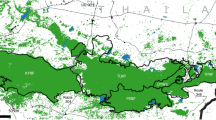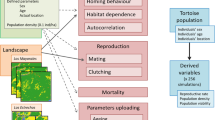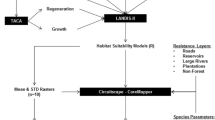Abstract
Conserving species-at-risk requires quantifiable knowledge of the key drivers of population change. Non-linear demographic responses to habitat loss have been documented for many species and may serve to establish quantitative habitat thresholds for management purposes. In Canada, boreal populations of woodland caribou are considered threatened; Environment Canada’s empirical model of calf recruitment–range disturbance suggests that at least 65% undisturbed habitat is required to ensure viability. We tested the relationship upon which this conservation guideline is based by pairing demographic estimates with range conditions over a 10-year period for three boreal caribou populations. Our objectives were (1) to evaluate evidence of intra-population demographic responses to fluctuations in range quality over time; (2) to evaluate inter-population differences in demographic responses to cumulative range disturbances; and (3) to evaluate the sensitivity of disturbance tolerance thresholds to variation in local population demography. We found strong evidence in support of the disturbance–recruitment relationship for within-population responses over time (R2 = 0.77). Mixed effects logistic regression modeling revealed variations in local population responses to cumulative habitat depletion. Range-specific disturbance thresholds derived from Monte Carlo simulations were highly elastic in response to observed variation in local population demography, suggesting that 65% undisturbed habitat is insufficient when adult female survival and/or sex ratio is suboptimal. Study populations were determined to be not self-sustaining (Pr(λ ≥ 0.99) = 37–47%). Adult survival was comparable to estimates reported elsewhere despite Aboriginal harvesting for subsistence purposes. Results underscored potential trade-offs between forest harvesting and wildlife habitat conservation. Protection and restoration of sufficient quantities of undisturbed habitat, particularly via road reclamation, is essential for caribou population recovery.



Similar content being viewed by others
References
Adams LG (2005) Effects of maternal characteristics and climatic variation on birth masses of Alaskan caribou. J Mamm 86:506–513
Bastille-Rousseau G, Dussault C, Couturier S, Fortin D, St-Laurent M-H, Drapeau P, Dussault C, Brodeur V (2012) Sélection d’habitat du caribou forestier en forêt boréale québécoise. Ministère du Développement durable, de l’Environnement, de la Faune et des Parcs, Québec
Bergerud AT, Ferguson R, Butler HE (1990) Spring migration and dispersion of woodland caribou at calving. Anim Behav 39:360–368
Brodeur V, Rivard S, Jutras C (2013) Inventaire du caribou forestier dans les secteurs Assinica et Broadback en 2003. Ministère des Ressources naturelles du Québec, Chibougamau
Canada Environment (2008) Scientific review for the identification of critical habitat for woodland caribou (Rangifer tarandus caribou), boreal population, in Canada. Environment Canada, Ottawa
Canada Environment (2011) Scientific assessment to inform the identification of critical habitat for woodland caribou (Rangifer tarandus caribou), boreal population, in Canada: 2011 update. Environment Canada, Ottawa
Canada Environment (2012) Recovery strategy for the woodland caribou, boreal population (Rangifer tarandus caribou) in Canada. Environment Canada, Ottawa
Courtois R, Gingras A, Dussault C, Breton L, Ouellet J-P (2003) An aerial survey technique for the forest-dwelling ecotype of woodland caribou, Rangifer tarandus caribou. Can Field Nat 117:546–554
Courtois R, Ouellet J-P, Breton L, Gingras A, Dussault C (2007) Effects of forest disturbance on density, space use, and mortality of woodland caribou. Écoscience 14:491–498
Cyr D, Gauthier S, Bergeron Y, Carcaillet C (2009) Forest management is driving the eastern North American boreal forest outside its natural range of variability. Front Ecol Environ 7:519–524
Drapeau P, Leduc A, Bergeron Y (2009) Bridging ecosystem and multiple species approaches for setting conservation targets in managed boreal landscapes. In: Villard M-A, Jonsson BG (eds) Setting conservation targets for managed forest landscapes. Cambridge University Press, New York, pp 129–160
Drapeau P, Leduc A, Hannon SJ, Villard M-A (2016) Natural disturbance regimes as templates for the response of bird species assemblages to contemporary forest management. Divers Distrib 22:385–399
Dussault C, Gravel S (2008) Inventaire du caribou forestier à l’hiver 2007 au Saguenay-Lac-Saint-Jean. Ministère des Ressources naturelles et de la Faune, Jonquière
Dussault C, Courtois R, Ouellet J-P, Huot J (2001) Influence of satellite geometry and differential correction on GPS location accuracy. Wildl Soc Bull 29:171–179
Dussault C, Pinard V, Ouellet J-P, Courtois R, Fortin D (2012) Avoidance of roads and selection for recent cutovers by threatened caribou: fitness-rewarding or maladaptive behaviour? Proc R Soc B 279:4481–4488
Faille G, Dussault C, Ouellet JP, Fortin D, Courtois R, St-Laurent MH, Dussault C (2010) Range fidelity: the missing link between caribou decline and habitat selection? Biol Conserv 143:2840–2850
Festa-Bianchet M, Ray JC, Boutin S, Côté SD, Gunn A (2011) Conservation of caribou (Rangifer tarandus) in Canada: an uncertain future. Can J Zool 89:419–434
Foster BL, Tilman D (2000) Dynamic and static views of succession: testing the descriptive power of the chronosequence approach. Plant Ecol 146:1–10
Gaillard J-M, Festa-Bianchet M, Yoccoz NG, Loison A, Toïgo C (2000) Temporal variation in fitness components and population dynamics of large herbivores. Annu Rev Ecol Evol Syst 31:367–393
Gauthier S, Raulier F, Ouzennou H, Saucier J-P (2015) Strategic analysis of forest vulnerability to risk related to fire: an example from the coniferous boreal forest of Quebec. Can J For Res 45:553–565
Gitzen RA, Millspaugh JJ, Kernohan BJ (2006) Bandwidth selection for fixed-kernel analysis of animal utilization distributions. J Wildl Manag 70:1334–1344
Gouvernement du Québec and Crees of Québec (2002) Agreement concerning a new relationship (Paix des Braves) between le Gouvernement du Québec and the Crees of Québec. Gouvernement du Québec, Québec
Hatter IW, Bergerud WA (1991) Moose recruitment, adult mortality and rate of change. Alces 27:65–73
Heisey DM, Fuller TK (1985) Evaluation of survival and cause-specific mortality rates using telemetry data. J Wildl Manag 49:668–674
Imbeau L, St-Laurent MH, Marzell L, Brodeur V (2015) Current capacity to conduct ecologically sustainable forest management in northeastern Canada reveals challenges for conservation of biodiversity. Can J For Res 45:567–578
Jacqmain H, Dussault C, Courtois R, Bélanger L (2008) Moose-habitat relationships: integrating local Cree native knowledge and scientific findings in northern Quebec. Can J For Res 38:3120–3132
Johnson CJ (2013) Identifying ecological thresholds for regulating human activity: effective conservation or wishful thinking? Biol Conserv 168:57–65
Laliberte AS, Ripple WJ (2004) Range contractions of North American carnivores and ungulates. Bioscience 54:123–138
Lande R (1987) Extinction thresholds in demographic models of territorial populations. Am Nat 130:624–635
Leblond M, Dussault C, Ouellet J-P (2013) Impacts of human disturbance on large prey species: do behavioral reactions translate to fitness consequences? PLoS ONE 8:e73695
Leblond M, Dussault C, Ouellet J-P, St-Laurent M-H (2016) Caribou avoiding wolves face increased predation by bears—caught between Scylla and Charybdis. J Appl Ecol 53:1078–1087
Leclerc M, Dussault C, St-Laurent M-H (2014) Behavioural strategies towards human disturbances explain individual performance in woodland caribou. Oecologia 176:297–306
Lesmerises F, Dussault C, St-Laurent M-H (2012) Wolf habitat selection is shaped by human activities in a highly managed boreal forest. For Ecol Manag 276:125–131
Lesmerises R, Ouellet J-P, Dussault C, St-Laurent M-H (2013) The influence of landscape matrix on isolated patch use by wide-ranging animals: conservation lessons for woodland caribou. Ecol Evol 3:2880–2891
Levin N, Mazor T, Brokovich E, Jablon PE, Kark S (2015) Sensitivity analysis of conservation targets in systematic conservation planning. Ecol Appl 25:1997–2010
Losier C, Couturier S, St-Laurent M-H, Drapeau P, Dussault C, Rudolph TD, Brodeur V, Merkle J, Fortin D (2015) Adjustments in habitat selection to changing availability induce fitness costs for a threatened ungulate. J Appl Ecol 52:496–504
Polfus JL, Hebblewhite M, Heinemever K (2011) Identifying indirect habitat loss and avoidance of human infrastructure by northern mountain woodland caribou. Biol Conserv 144:2637–2646
Poole KG, Cuyler C, Nymand J (2013) Evaluation of caribou (Rangifer tarandus groenlandicus) survey methodology in West Greenland. Wildl Biol 19:225–239
Rasiulis ALV, Schmelzer I, Wright CG (2012) The effect of temporal sampling regime on the characterization of home range for female boreal woodland caribou (Rangifer tarandus caribou) in Labrador, Canada. Rangifer 32:227–239
Rudolph T, Drapeau P, St-Laurent M-H, Imbeau L (2012) Status of woodland caribou (Rangifer tarandus caribou) in the James Bay Region of Northern Quebec. Scientific Advisory Group, Woodland Caribou Recovery Task Force, Nord-du-Québec, Montréal
Schaefer JA (2003) Long-term range recession and the persistence of caribou in the Taiga. Conserv Biol 17:1435–1439
Schaefer JA, Wilson CC (2002) The fuzzy structure of populations. Can J Zool 80:2235–2241
Seip DR (1992) Factors limiting woodland caribou populations and their interrelationships with wolves and moose in southeastern British Columbia. Can J Zool 70:1494–1503
Sleep D, Loehle C (2010) Validation of a demographic model for woodland caribou. J Wildl Manag 74:1508–1512
Sorensen T, McLoughlin PD, Hervieux D, Dzus E, Nolan J, Wynes B, Boutin S (2008) Determining sustainable levels of cumulative effects for boreal caribou. J Wildl Manag 72:900–905
St-Laurent M-H, Ferron J, Hins C, Gagnon R (2007) Effects of residual stand structure and landscape characteristics on habitat use by birds and small mammals in logged boreal forest. Can J For Res 37:1298–1309
Tyler NJC (2010) Climate, snow, ice, crashes, and declines in populations of reindeer and caribou (Rangifer tarandus L.). Ecol Monogr 80:197–219
UN General Assembly (2008) United Nations Declaration on the Rights of Indigenous Peoples: resolution/adopted by the General Assembly. A/RES/61/295, 2 Oct 2007
Villard M-A, Jonsson BG (2009) Setting conservation targets for managed forest landscapes. Cambridge University Press, New York
Vors LS, Schaefer JA, Pond BA, Rodgers AR, Patterson BR (2007) Woodland caribou extirpation and anthropogenic landscape disturbance in Ontario. J Wildl Manag 71:1249–1256
Whittington J, Hebblewhite M, DeCesare NJ, Neufeld L, Bradley M, Wilmshurst J, Musiani M (2011) Caribou encounters with wolves increase near roads and trails: a time-to-event approach. J Appl Ecol 48:1535–1542
Wittmer HU, McLellan BN, Serrouya R, Apps C (2007) Changes in landscape composition influence the decline of a threatened woodland caribou population. J Anim Ecol 76:568–579
Acknowledgements
We wish to thank I. Schmelzer and M. Festa-Bianchet for suggesting constructive improvements to a previous version of this manuscript. Thanks to G. Hétu, S. Rivard, L. Lambert, C. Jutras and F. Manka for their scientific and logistical support coordinating the caribou telemetry surveys and datasets, to M.J. Mazerolle for his assistance with statistical analyses, and M. Desrochers for GIS support. This project was funded by the Ministère des Forêts, de la Faune et des Parcs du Québec (MFFP) to support the work of a regional task force in collaboration with the Cree Nation Government.
Author information
Authors and Affiliations
Corresponding author
Additional information
Communicated by Karen E. Hodges.
Rights and permissions
About this article
Cite this article
Rudolph, T.D., Drapeau, P., Imbeau, L. et al. Demographic responses of boreal caribou to cumulative disturbances highlight elasticity of range-specific tolerance thresholds. Biodivers Conserv 26, 1179–1198 (2017). https://doi.org/10.1007/s10531-017-1292-1
Received:
Revised:
Accepted:
Published:
Issue Date:
DOI: https://doi.org/10.1007/s10531-017-1292-1




